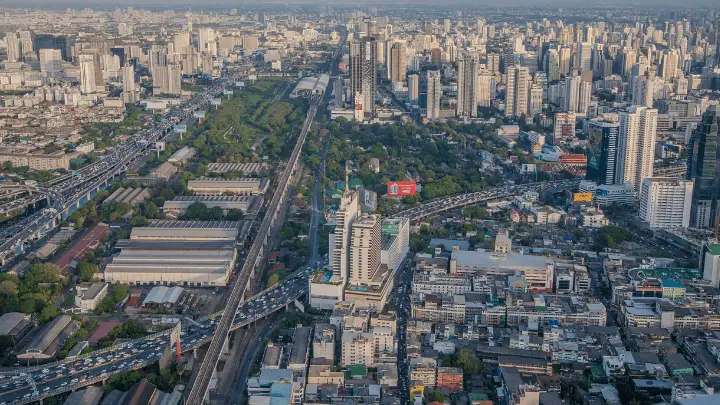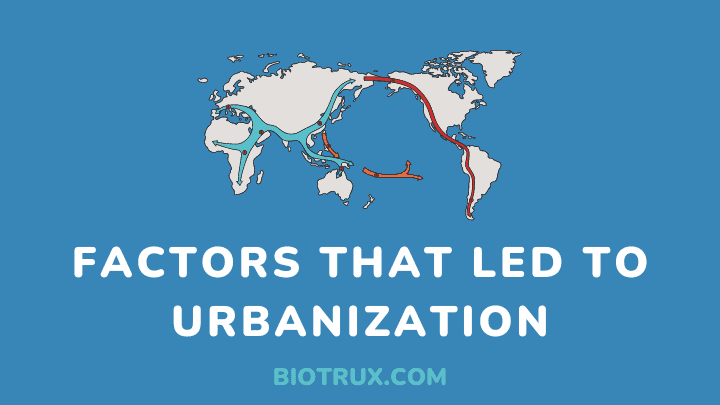Urbanization has been a defining phenomenon of the modern era. According to Statista, 2019 and 2020 experienced 55.71% and 56.15% increases in the urban population, respectively. But what drives people to cities? What are the factors that led to this rate of urbanization?
In this article, I’ll delve into what has caused millions of people to relocate from their rural homes to bustling cities, exploring political, economic, and social factors and more.
By understanding the forces that have driven urbanization, city planners, business owners, and individuals can better prepare for the future of our rapidly changing world.
What is the Importance of Studying Urbanization?
As the population of our cities continues to swell, we must understand the implications of urbanization and its capacity for change. The urbanization processes are complex and require careful study to understand how they shape the modern city.
From understanding a city’s public health and social dynamics to recognizing the influence of urban economics on development patterns, studying urbanization provides insights into how cities work and evolve.
Urban studies also help us better comprehend how cities can adapt to global challenges. As humanity faces ever-greater environmental pressures, we urgently need to rethink how our cities function.
By studying urbanization, we can develop smarter approaches to managing the growth of our cities, ensuring that prosperity and sustainability remain top priorities for future generations.
The following are some of the factors that led to urbanization:
1. Historical Factors That Led to Urbanization
Agricultural revolution
The agricultural revolution of the 18th century provided citizens with a reliable source of food, enabling them to stay in one place. Eventually, it caused a population increase that drove more people into cities.
The increased food availability for urban areas also allowed for population growth. Crop rotation and other new farming techniques helped spur this productivity growth.
Hence, it triggered the industrial revolution, which saw the movement of people from rural areas to cities as jobs became more available. This mass migration led to the rapid expansion of cities, which were the precursors to modern metropolises.
Industrial revolution (industrialization)
The industrial revolution of the 18th and 19th centuries gave rise to a new way of life in urban centers. Before this, rural areas had been the traditional home for families and businesses.
However, with the invention of new machines and technologies, factories could be opened in cities and towns, giving people better access to employment opportunities. As more people moved to cities for work, urban populations grew exponentially.
Thus, industrialization laid the foundation for the earliest stages of urbanization, and its effects continue exponentially across both rural and urban areas today.
2. Economic Factors That Led to Urbanization
Job opportunities and higher wages
Urbanization has long been an established consequence of job opportunities in today’s economy. As more and more people flock to cities for the promise of better wages and access to employment, metropolitan areas have grown exponentially throughout history.
In cities with high-paying labor, businesses are more likely to locate there, thus increasing the population and stimulating growth. Plentiful employment opportunities in cities motivate young people to migrate from rural areas to towns and cities for a new life.
Access to goods and services
Cities offer more access to jobs, medical care, transportation, education, shopping options, and housing than rural locations. As people move to cities for better living standards, businesses expand to meet their needs.
This creates a cycle of urban growth fuelled and reinforced by access to goods and services. With increasing prosperity comes improved infrastructure, which attracts even more people to the city, leading to further development.
3. Social Factors That Led to Urbanization
Population growth
The rapid growth in population since the industrial revolution has been a significant driving force in the world’s urbanization. This exponential increase in population has put pressure on urban areas, leading to overcrowding, resource scarcity, and health issues.
This has led people and businesses to expand into urban spaces for more space, resources, and opportunities.
As a result, cities increasingly become densely populated megacities as rural populations shift to urban ones in search of employment, education, and other services.
Changes in family structure
The shift from traditional family structures has been a major factor driving urbanization. The rise of nuclear families, with smaller family members living closer to each other, has provided the perfect catalyst for populations to move toward cities and towns.
With such a huge influx of people to cities, families had to abandon the extended family concept. Now, families focus on creating a nuclear unit to support themselves in a highly competitive economic environment.
4. Environmental Factors that Led to Urbanization
Urbanization has been a major feature of human development in the 21st century as more and more people move to cities.
Several environmental factors have contributed to this trend, from changing weather patterns caused by climate change to conflicts arising from limited natural resources in rural areas.
Rising sea levels, pollution, earthquakes, and extreme temperatures have forced many to migrate for better living conditions. A major example is the earthquake in Turkey on the 6th of February, 2023.
An IOM report titled ‘2023 Earthquakes Displacement’ reveals that 2.7 million people have fled the disaster area. Human beings are always searching for better living conditions, which can lead to rapid urbanization if unchecked.
5. Political Factors That Led to Urbanization
Government policies
Governments have played a major role in creating policies encouraging people to migrate from rural areas to more urban locales.
Tax incentives, infrastructure investments, zoning laws, and other regulations are examples of tools employed by governments to boost the growth and development of cities. Government policies can increase service demand as people migrate to cities for economic opportunities.
Such services include but are not limited to housing, transportation, education, health care, and waste management – bringing about rapid urbanization.
Land ownership
Historically, those with access to resources like land have held power over their communities. Land ownership is often concentrated among a small elite class, which can lead to excessive urban growth.
This phenomenon is especially apparent in countries where access to land is restricted due to its concentration in the hands of a powerful few.
As a result, those who lack access to land may be forced to move into cities, leading to more urban sprawl and an increase in population density.
What Are the Current Trends in Urbanization?

Urbanization is one of the most dramatic changes in our modern landscape. Over the last few decades, cities worldwide have grown exponentially – becoming larger and more interconnected than ever. Two particular trends in urbanization are urban sprawl and megacities.
Urban sprawl is the haphazard development spread over land previously used for agriculture or other open space. This phenomenon has caused a massive increase in travel times and energy consumption, hurting air and water quality.
Conversely, megacities refer to large metropolitan areas with 10 million or more populations. These vast urban settlements pose immense logistical challenges but can also offer great opportunities, such as increased access to services and employment.
However, as populations continue to grow, cities are expanding rapidly, and there is an increasing focus on creating smart cities with highly developed infrastructure and technology.
Along with this comes an increased emphasis on sustainability, with efforts to reduce emissions, promote renewable energy sources, and develop green public recreational spaces.
Additionally, there has been a surge in urban renewal projects, often including preserving historic buildings and monuments. These trends have implications for businesses, governments, and citizens alike, providing opportunities for innovation and creative problem-solving.
FAQs
What is the difference between urbanization and industrialization?
Urbanization refers to people moving from rural areas to cities, while industrialization refers to developing industries in a country or region. Urbanization is often a result of industrialization, as cities provide job opportunities in the industrial sector.
How does urbanization negatively impact the environment?
Urbanization can lead to deforestation, air and water pollution, and the depletion of natural resources. However, sustainable urban development practices can help mitigate these negative impacts.
Why is sustainable urban development important?
Sustainable urban development aims to ensure that cities meet the needs of the current generation without compromising the needs of the next generation. It promotes economic growth, social inclusion, and environmental sustainability.
The Way Forward
Urbanization has had a dramatic and far-reaching impact on our world, and each contributing factor is deeply interconnected. From the advent of modern transportation to shifting political economies, urbanization can be seen as a result of multiple vital influences.
As cities grow and evolve, it’s essential to remember that each factor contributes to an ever-changing landscape. The trend of urbanization is here to stay, with cities becoming more crowded and complex as populations grow.
Hence, understanding these factors is critical to ensuring we create healthier and more equitable societies for all.
For more information on urbanization, read my article discussing the relationship between urbanization and the environment.
Thanks for reading.
